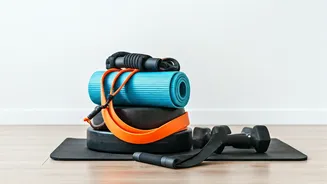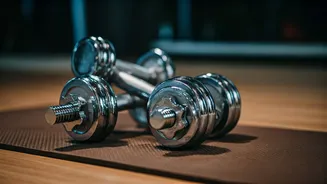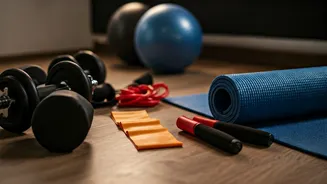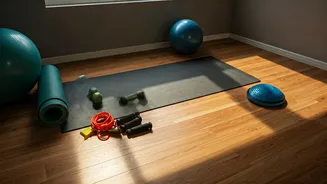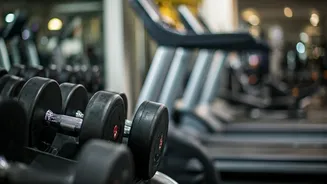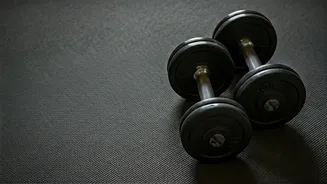Core Bodyweight Exercises
Bodyweight exercises are a fantastic way to begin or improve a fitness regime. One of the most common and beneficial is the push-up. The push-up targets
the chest, shoulders, and triceps, enhancing upper-body strength. Start with a proper plank position, hands shoulder-width apart, and lower your body until your chest nearly touches the floor. Push back up, maintaining a straight body from head to heels. Next is the plank hold. This exercise is exceptional for core strength and stability. Hold a plank position, keeping your body in a straight line, your core engaged, and your shoulders directly above your elbows. Aim to hold it for as long as possible. The burpee is a dynamic, full-body exercise. Begin standing, then drop into a squat, kick your feet back into a push-up position, perform a push-up, jump your feet back to your hands, and leap into the air. Burpees are incredible for cardiovascular health and burning calories. Lastly, the mountain climber is another great exercise for your core. Begin in a push-up position, alternate bringing your knees towards your chest, maintaining a steady pace. These exercises together offer a comprehensive full-body workout using only your body weight.
Leg and Glute Workouts
Leg and glute exercises are crucial for lower body strength and overall fitness. Bodyweight squats are a foundational exercise. Stand with your feet shoulder-width apart, lower your hips as if sitting in a chair, keeping your back straight and your core engaged. Push back up to the starting position. It's a highly effective exercise for the quads, hamstrings, and glutes. Glute bridges are a great way to strengthen your glutes and hamstrings. Lie on your back with your knees bent and feet flat on the floor. Lift your hips off the floor, squeezing your glutes at the top of the movement. Hold for a moment, then lower back down. This exercise is excellent for improving hip extension. Wall sits, while seemingly simple, are a demanding exercise for your quads. Stand with your back against a wall, slide down until your thighs are parallel to the floor, as if sitting in an imaginary chair, and hold the position. These exercises will provide a good lower body workout using your body weight.
Cardio-Based Movements
Incorporating cardio exercises into your bodyweight routine is vital for cardiovascular health and weight management. High knees are a fantastic way to elevate your heart rate. Stand with your feet hip-width apart and bring your knees up towards your chest, alternating legs and maintaining a fast pace. This exercise is perfect for warming up or as part of a HIIT routine. Jumping jacks are another classic exercise for cardio. Jump your feet out to the sides while raising your arms above your head and then jump back to the starting position. It boosts heart rate and engages multiple muscle groups. Mountain climbers, previously mentioned, also serve as effective cardio. They increase your heart rate while working your core and upper body. Burpees, also discussed, provide an intense cardio workout, burning a large number of calories in a short amount of time. Adding these cardio-based exercises to your routine enhances your cardiovascular endurance and overall fitness levels.
Workout Routine Examples
Creating a well-rounded bodyweight workout involves combining different exercises to target various muscle groups. A basic beginner routine could include 3 sets of 10 push-ups, 3 sets of a 30-second plank hold, 3 sets of 15 squats, and 3 sets of 10 glute bridges, with a minute's rest between sets. For an intermediate workout, consider 3 sets of 15 push-ups, 3 sets of 1-minute plank, 3 sets of 20 squats, 3 sets of 15 glute bridges, and adding 3 sets of 10 burpees, also with a minute's rest. For a more intense session, try an advanced routine with 4 sets of 20 push-ups, 4 sets of 1-minute plank, 4 sets of 25 squats, 4 sets of 20 glute bridges, and 4 sets of 15 burpees, along with high knees and mountain climbers added for an extra cardio challenge. It is essential to adjust the sets and repetitions based on individual fitness levels and to gradually increase the intensity to avoid injury and maximize results. These routines can be modified and personalized to meet your fitness objectives.
Form and Technique
Proper form is paramount when performing bodyweight exercises to prevent injuries and optimize effectiveness. When doing push-ups, ensure your body forms a straight line from head to heels and engage your core to stabilize your spine. Lower your chest until it nearly touches the ground and push back up. For squats, maintain a straight back, keep your core engaged, and lower your hips as if sitting in a chair. Avoid letting your knees go past your toes. During plank holds, keep your body in a straight line from head to heels, engage your core, and keep your shoulders directly above your elbows. Maintain a controlled movement throughout all exercises. Focus on slow, controlled movements to activate muscles and avoid using momentum. Pay attention to your body and rest when necessary. If you're unsure about the form, watch videos or consult a fitness professional to avoid injury and maximize the effectiveness of the exercise. Practicing proper form builds muscle and increases overall fitness.
Warm-up and Cool-down
A comprehensive fitness routine should always include a proper warm-up and cool-down to prepare your body for the workout and facilitate recovery. Before starting your workout, perform a dynamic warm-up that includes arm circles, leg swings, torso twists, and other mobility exercises. These movements increase blood flow, and flexibility, and prepare your muscles for activity. Incorporate 5-10 minutes of gentle exercises, such as light cardio like jumping jacks or high knees. After completing your workout, incorporate static stretches to cool down. Hold each stretch for 20-30 seconds, focusing on major muscle groups you worked during the session, such as the chest, shoulders, quads, hamstrings, and glutes. During static stretches, avoid bouncing and breathe slowly and deeply. A proper warm-up and cool-down routine minimizes the risk of injury, improves flexibility, and accelerates recovery, helping you get the most out of your bodyweight exercises and improve your overall health and fitness.
